August 2022
- English
- 日本語
Refined “Kyo” Bamboo Shoot Cuisine
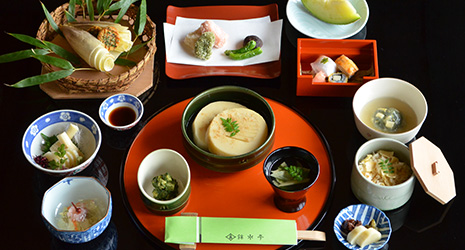
Some of the range of bamboo shoot dishes that feature in Kinsuitei’s full course menu 
Kinsuitei is situated on the shore of Hachijoga-ike Pond in Nagaokakyo City. Azaleas bloom in the bamboo shoot season
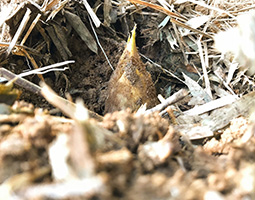
The tip of a bamboo shoot poking out of the ground 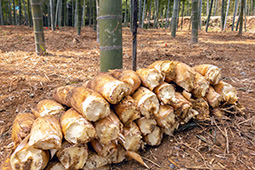
Freshly harvested bamboo shoots in the forest 
Jikitake, simmered slices of bamboo shoots 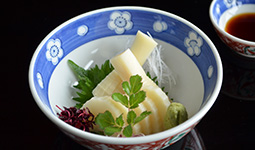
Otsukuri, thinly sliced bamboo shoot tips 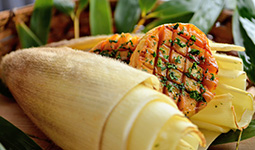
Yakitake, seared and roasted bamboo shoots

Kinsuitei is a Japanese restaurant which serves unique dishes featuring bamboo shoots grown by the restaurant itself. It is situated in Nagaokakyo City, briefly Japan’s capital around 1,200 years ago, in the west of present-day Kyoto Prefecture*.

Bamboo shoots, or takenoko in Japanese, are the edible young shoots that emerge from the underground rhizomes (similar to roots) of bamboo. They are ready to eat when their tips begin to poke out of the ground in bamboo forests during spring, and are a food that heralds the arrival of the season for Japanese people. There are various popular ways to enjoy bamboo shoots, such as simmered dishes, soups, and tempura.
Bamboo shoots harvested mainly in the area around Nagaokakyo City in Kyoto Prefecture from late March to mid-May are referred to as “Kyo” (short for Kyoto) bamboo shoots and are considered a luxury foodstuff. Kinsuitei is a traditional Japanese restaurant established in 1881 on the shore of Hachijoga-ike Pond adjacent to Nagaoka Tenmangu Shrine in Nagaokakyo City and serves seasonal Kyoto cuisine. The cultivation of the bamboo shoots that feature on the restaurant’s menu is handled entirely by the restaurant itself.
“The appeal of Kyo bamboo shoots is their subtly sweet aroma and soft texture. However, their flavor only lasts for the brief period of time when the bamboo shoots are still in the ground. Exposure to light and air makes them grow rapidly and they get tougher with a stronger egumi** taste. Their aroma also deteriorates,” says Ikeda Hisashi, the fifth-generation head of Kinsuitei. “So we locate a slight crack in the ground and dig up the young bamboo shoots before their tips emerge.”

As bamboo shoots grow, their outer skin toughens and darkens. In contrast, the outer skin of young bamboo shoots that have not yet emerged from the earth is light brown to cream-colored and, unlike full-grown bamboo shoots, is tender and almost totally free of egumi. In order to harvest bamboo shoots that are of sufficiently high quality to use in cooking, bamboo forests must be tended year-round. In the Nishiyama area of Kyoto that is home to Kinsuitei, a unique traditional cultivation method has been passed down from generation to generation. This involves fertilization and pruning parent bamboo in summer, then placing straw and earth over the floor of the bamboo forest from fall through winter to create a soft layer of soil suitable for bamboo shoots to grow. This unique cultivation method is found nowhere else in Japan and is what makes Kyo bamboo shoots a luxury foodstuff.

During the bamboo shoot season, Ikeda goes to the bamboo forest early in the morning accompanied by a relative to dig up bamboo shoots. When the bamboo shoots are unearthed, they are immediately placed in boiling water and boiled for two hours. The final step in the preparation process is to soak them in cold spring water for 30 to 60 minutes. Bamboo shoots dug up in the morning are served in the restaurant the same day.
From late March through May, Kinsuitei serves a full course menu featuring bamboo shoots harvested that morning. This includes the restaurant’s signature dishes of jikitake and otsukuri, which are only served during the peak bamboo-shoot season from April to mid-May.
Jikitake consists of round slices of bamboo shoots cooked (simmered) in special stock, with katsuobushi (shavings of simmered, smoked and fermented skipjack tuna) added at the end of the cooking process. Despite the dish’s robust appearance, jikitake has a very soft texture and the refined flavor of Kyo bamboo shoots is quite clear. Otsukuri is a dish in which the tips and other particularly tender parts of bamboo shoots are sliced thinly like sashimi, then beautifully arranged in a small bowl and served with a little special stock and soy sauce.


Another dish, yakitake, is made by brushing bamboo shoots with a special soy-based sauce and searing them over an open flame, then wrapping them in the skin of bamboo shoots and roasting them to intensify the aroma.

Says Ikeda, “Guests who taste our Kyo bamboo shoots full course menu often say they are surprised by the softness of the bamboo shoots and their sweetly fragrant aroma.”
Kinsuitei aims to protect Kyoto’s culinary traditions alongside the bamboo forest that produces Kyo bamboo shoots for future generations.
* Nagaokakyo was the capital of Japan from 784 to 794, before the capital was moved to present-day Kyoto. It corresponds to the present-day Muko City, Nagaokakyo City, and Kyoto City Nishikyo Ward in Kyoto Prefecture.
** Bitterness or unpleasant acrid taste resulting from the presence of lye in bamboo shoots and other edible wild plants.

